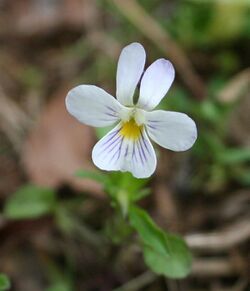Biology:Viola bicolor
From HandWiki
Revision as of 23:02, 13 August 2022 by imported>NBrush (simplify)
Short description: Species of flowering plant
| Viola bicolor | |
|---|---|

| |
| A light morph of Viola bicolor growing in a sandy field along the mouth of the James River in southeastern Virginia | |
| Scientific classification | |
| Kingdom: | Plantae |
| Clade: | Tracheophytes |
| Clade: | Angiosperms |
| Clade: | Eudicots |
| Clade: | Rosids |
| Order: | Malpighiales |
| Family: | Violaceae |
| Genus: | Viola |
| Species: | V. bicolor
|
| Binomial name | |
| Viola bicolor Pursh
| |
| Synonyms | |
| |
Viola bicolor, commonly known as the American field pansy or wild pansy, is an annual plant in the violet family found throughout much of North America. There is some debate as to whether the plant is native here, or if it was introduced from the Old World as a variety of Viola kitaibeliana, but it is now generally thought to be native to the North America.[2] It is common in disturbed habitats, but is also found in fields and open woods on substrates ranging from sandy soil to clay to limestone.[3][4][5]
References
- ↑ "Viola bicolor". NatureServe Explorer. NatureServe. http://www.natureserve.org/explorer/servlet/NatureServe?searchName=Viola+bicolor+.
- ↑ Flora of North America
- ↑ Clausen, Jen; Channell, R.B.; Nur, Uzi (1964), "Viola rafinesquii, the only Melanium violet native to North America", Rhodora 66 (17)
- ↑ McKinney, Landon E.; Russel, Norman H. (2002), "Violaceae of the Southeastern United States", Castanea 67 (4): 369–379
- ↑ Hayden, W. John; Clough, John (1990), "Methyl Salicylate Secretory Cells in Roots of Viola arvensis and V. rafinesquii (Violaceae)", Castanea 55 (1): 65–70
External links
Wikidata ☰ Q14420159 entry


